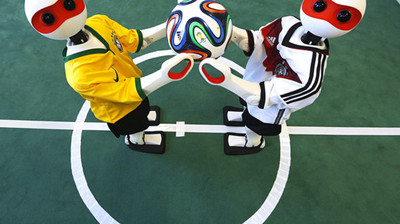MESSI v the Machine was how some commentators touted the World Cup final, inspired by the disciplined way the German team dismantled Brazil in the semi-finals. But despite such caricatures of Teutonic precision, German players are only human. So as the latest edition of RoboCup, a competition for robot soccer players rather than flesh-and-blood ones, kicks off on July 19th in Jo?o Pessoa, Brazil's easternmost city, a question that will be on many minds is: when will real machines conquer the sport?
世界杯半決賽中,德國干掉了巴西。受這種一板一眼的踢法的刺激,一些評論人員戲稱世界杯決賽為“梅西對戰(zhàn)機器”。但是盡管我們這樣諷刺條頓式精密,德國隊員也仍是人類。而機器人世界杯則是機器足球運動員的賽事,無關(guān)有血有肉的人類。因此,今年7月19日,當機器人世界杯在巴西最東端的城市圣保羅開賽的時候,許多人開始考慮:真的機器,什么時候會統(tǒng)治足球運動?
1997年,第一屆機器人世界杯舉行的時候,創(chuàng)始者們設(shè)定的目標是2050年,工程師能開發(fā)出類人的機器隊伍,媲美舊有比賽的冠軍。通過一些機器人世界杯隊員的沉重步伐來看, 這個目標還遙遙無期。但是人們往往會低估機器人發(fā)展的速度。無人駕駛汽車和無人運輸機十年前看上去也是遙不可及的,如今已成為嚴肅的商業(yè)興趣點。
By comparison with the corporate investments of the likes of Google in electric cars, the teams competing in this year's RoboCup—more than 150 of them—have shoestring budgets. But the tournament includes features that the organisers hope will accelerate innovation without the incentive of cash.
對比谷歌因?qū)﹄妱悠嚨钠枚M行的合作投資,今年機器人世界杯的150多支隊伍的預(yù)算不過是毛毛雨。但是比賽有這樣一個特點,組織方希望在沒有資本刺激的情況下加速創(chuàng)新。
One is a clever combination of competition and co-operation. Leading up to the playoffs, teams prepare new strategies and fine-tune their hardware and software in secret. Immediately after the finals have been played, however, all must publish their methods, thus raising the bar for everyone the following year. Another feature is that there are limits to how far teams can push their hardware, to encourage them to develop smart routes to victory, rather than using mere brute force.
這項賽事是對競爭和合作的良好結(jié)合。進入了季后賽,各隊都會秘密準備新戰(zhàn)術(shù),調(diào)整軟硬件。然而,決賽一旦結(jié)束,所有人都要公開他們的方法,由此給其他人在明年的比賽提供參照。另一項特質(zhì)是對于隊伍對硬件做的改進是有上限的,以鼓勵他們開發(fā)智能方案贏得勝利,而不是僅僅通過粗魯?shù)奈锢硇阅堋?/div>
A further twist is that RoboCup is not one competition but many. These range from a little league of miniature cylinders on wheels, like the “Star Wars” character R2-D2, in which each entire team is controlled by one computer using input from overhead cameras, to a fully limbed humanoid league, akin to R2-D2's faithful companion, C-3PO (see picture above). In the humanoid league, which is further divided into three sizes of robot—kid, teen and adult—each android has its own independent on-board sensors and artificial-intelligence software.
更深一步的是,機器人世界杯不是一項比賽,而是一系列比賽。其范圍包括微型有輪缸式的小聯(lián)賽,到完全類人化的隊伍。前者類似“星球大戰(zhàn)”中的R2D2,整個隊伍由一臺電腦控制,輸入端為上空的攝像頭。后者好比R2D2的忠實隊友C3PO(見上圖)。在類人隊伍中,根據(jù)其不同的尺寸又分為小孩,青少年和成人,每個機器人都有其獨立的自帶傳感器,以及擬人智能軟件。
Moreover, for those who cannot be bothered to get out the spanners and the soldering iron, there is a virtual league as well. Competition there can focus on improving the software needed for the rapid planning of the best move at each step of the game, without having to worry about the vagaries of the hardware. And there is also a junior league for school-aged geeks, some of whom will no doubt join the RoboCup major leagues when they go to college, their skills already finely honed.
更有甚者,對于那些不善于使用扳手和焊接工具的人,也有虛擬隊伍。此處的比賽主要專注于能在比賽中快速規(guī)劃出最佳行動的軟件,而不在意硬件的搭配。還有校園極客的初級隊伍,他們在進入大學后無疑會加入機器人世界杯,畢竟他們的技巧已經(jīng)經(jīng)過考驗。
To sense the state-of-the-art in robot football, you need to go behind the scenes. Last week, hidden in a windowless office, Joydeep Biswas of Carnegie Mellon University and his colleagues were making final adjustments to their team, which competes in the little league. While robots in the humanoid league are still lumbering and prone to error, the speed and accuracy of those in the little league are stunning. Their electromechanical kickers can fire the league's orange golf balls at eight metres per second. In fact, they could easily shoot harder if it were not for hardware-control regulations that set a maximum speed.
為了體驗機器人足球的先進性,你要走近熒幕背后。上周,躲在一件無窗辦公室中,卡內(nèi)基·梅隆大學的Joydeep Biswas和他的伙伴對隊伍進行最后的調(diào)整。他們將在小聯(lián)賽中出現(xiàn)。盡管類人組機器人依然胡拼亂造而且容易出故障,其在小聯(lián)賽中的速度和精確性都有大幅提高。他們的電力學球員能夠以每秒八米的速度將比賽用橙色高爾夫球踢出去。實際上,如果不是硬件控制限制了最大速度的話,他們能夠踢得更狠。
The state of play
踢球的狀態(tài)
Mr Biswas, a graduate student, works for Manuela Veloso. She helped found RoboCup and her group has won the most finals titles in the little league. In 2009 Dr Veloso and her colleagues decided to share with their competitors the vision software that had let their team win a streak of RoboCups. This helped establish the now-mandatory open-source approach that has rapidly raised the quality of the competition.
研究生Biswas先生為Manuela Veloso工作。她幫助成立了機器人世界杯,而她的團隊已經(jīng)贏得了小聯(lián)賽中的多數(shù)頭銜。2009年Veloso博士及她的團隊決定同他們的競爭對手分享幫助他們贏得了一系列機器人世界杯的視覺軟件。這引導建立了如今的強制開源規(guī)則,并快速提升了比賽的質(zhì)量。
“In the past couple of years,” Dr Veloso opines, “one of the big changes is that we are starting to analyse real football tactics and strategy, to devise our own.” A paper her group published earlier this year lays out how their CMDragons team observed and exploited the defence tactics of opponents, luring them away from positions where they could prevent goals. This approach, dubbed “coerce and attack”, has parallels in professional playbooks.
Veloso博士說,“在過去的幾年,一項巨大的改變是我們開始分析實際足球技巧和策略,并衍生出我們自己的。”今年早些時候,她的團隊發(fā)表的一篇文章,說明了他們這個CMDragons團隊如何觀測并利用選手的防守戰(zhàn)略,引誘他們遠離能阻止球的防守位置。這個方法被叫做“威逼后攻擊”,已經(jīng)出現(xiàn)在專業(yè)玩家手冊中。
Other research groups are getting equally sophisticated, and teams from Australia, China, Iran and Thailand, among other countries, are regularly placed high in several leagues of the competition—in contrast to their national reputations on real pitches. In the early years of RoboCup, there were huge differences in quality between the teams. No longer. The best of the little league routinely finish their ten-minute-long games with the low scores characteristic of well-matched human teams. Indeed, Dr Veloso's squad came in second last year, after a penalty shoot-out following a 2-2 game.
其他的研究團隊也變得同樣的厲害。在所有國家中,來自澳大利亞,中國,伊朗和泰國的隊伍,同該國在實際比賽中的名聲相比,處在比賽的領(lǐng)頭羊地位。在機器人世界杯早些時候,各隊在質(zhì)量上大有不同。這一幕已成為歷史。小聯(lián)賽的佼佼者一般在10分鐘的比賽中以小比分結(jié)束,同人類隊伍間的比賽相仿。實際上,去年一場2-2的比賽結(jié)束后,Veloso的小隊在點球大戰(zhàn)中憾負中國隊,屈居第二。
Nor need only the players be robots. In a step that many of FIFA's critics may admire, Dr Veloso and her team are developing automated referees. That will not stop some teams from exploiting decidedly human traits, such as fouling by forcefully bumping into another robot. But it may result in more effective enforcement of things like the maximum kick-speed rule.
而且不僅僅運動員是機器人。許多世界杯批評人士可能會羨慕的是,Veloso博士及其團隊正在開發(fā)自動裁判。這不會阻止一些隊伍觸犯人類比賽中的規(guī)則,比如有力地碰撞另一個機器人。但其可能導致更有效的強化諸如最大踢球速度限制這樣的規(guī)定。
What fascinates Dr Veloso most about RoboCup is the execution, during the game, of moves that had not been deliberately inserted into the algorithms controlling the robots. She is ebullient about an unexpected three-way pass and chip, worthy of a minor Messi and his Argentine teammates. Such unanticipated plays are examples of emergent behaviour, a hallmark of artificial intelligence at its highest level, and something she reckons RoboCup teams in all leagues will produce a lot more of with each passing year.
機器世界杯最吸引Veloso博士的的地方在于,比賽期間,對運動的執(zhí)行不是事先設(shè)定在控制機器人的算法中。她樂于見到三角傳球過人,就像參照梅西和他的阿根廷隊友。這種意外的踢法是緊急處理中的例子,標志著人工智能的最高水平。她認為,每年機器世界杯各項比賽的隊伍會產(chǎn)生越來越多的閃光點。
So is 2050 an unrealistic deadline for robots to beat the best humans at football? Half a century is roughly the time that separates ENIAC, America's first electronic computer, from Deep Blue, the IBM machine that beat chess grandmaster Garry Kasparov in 1997. Judged in that light, RoboCup's goal does not seem absurd. Indeed, the question may be whether, come 2050, there are still any human football players around who have not been prosthetically enhanced in some way, making them cyborgs. RoboCup v RoboCop, anyone?
2050年是不是虛擬的截止日期,那時候機器人會在足球方面打敗人類?從美國第一臺電子計算機ENIAC到1997年IBM生產(chǎn)出打敗世界象棋大師Garry Kasparov的深藍,大概過去了一個世紀。由此判斷,機器人世界杯看上去并不荒唐。事實上,問題可能是到了2050年的時候,還有沒有足球運動員在某方面沒有進行強化,變成半機械人?機器人世界杯,還是半機器人世界杯?












